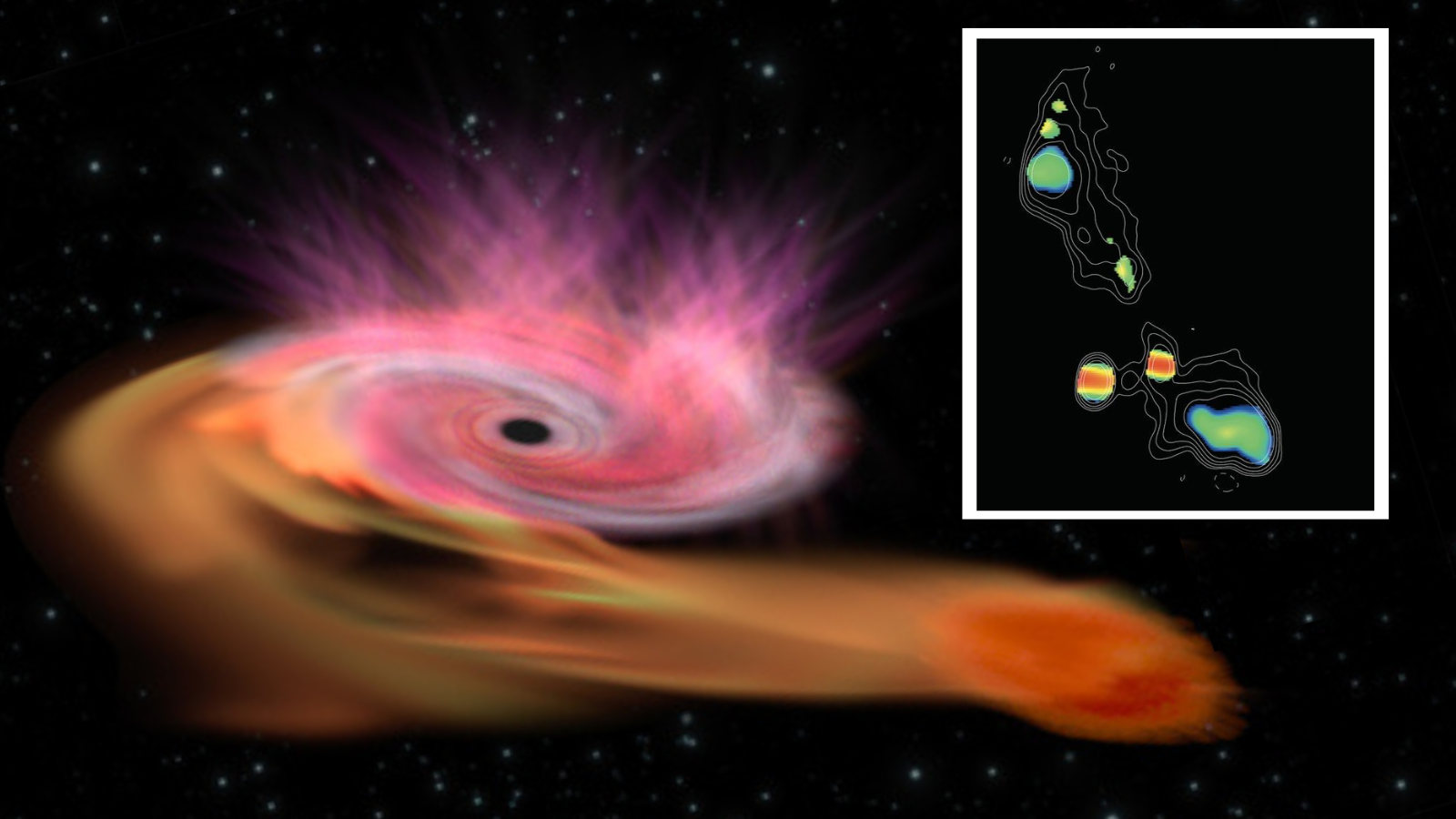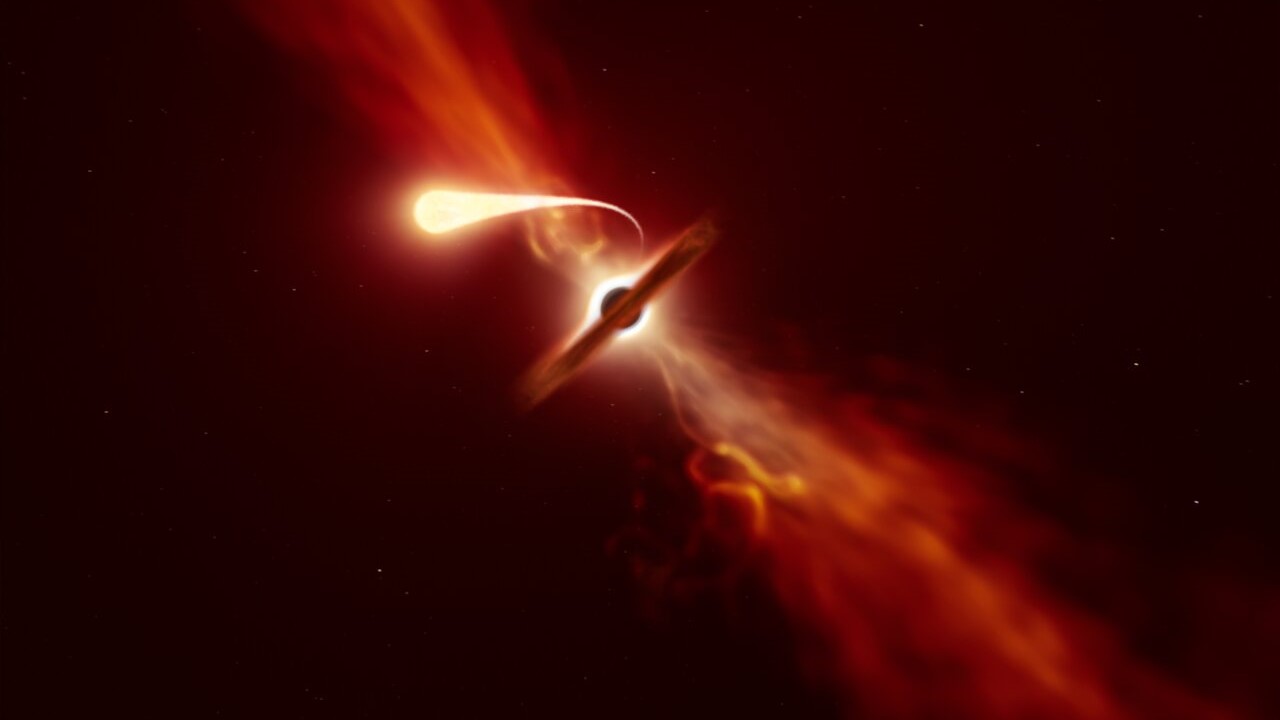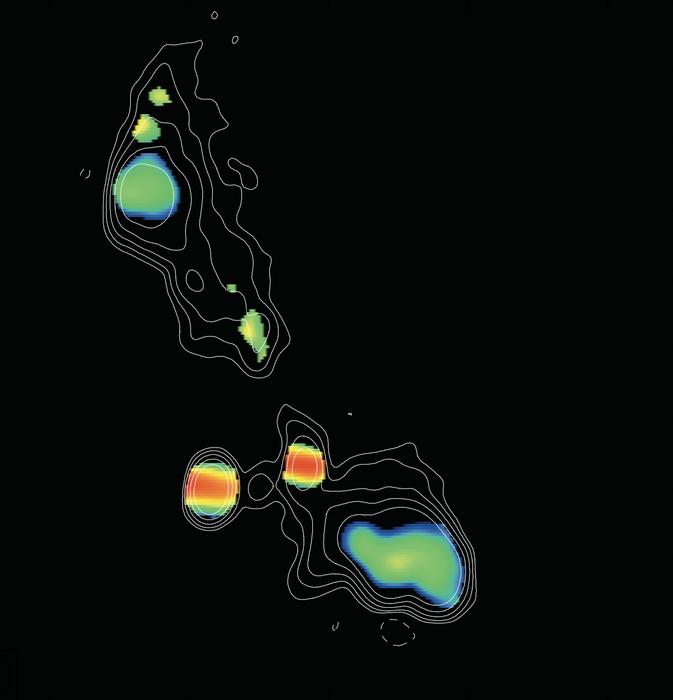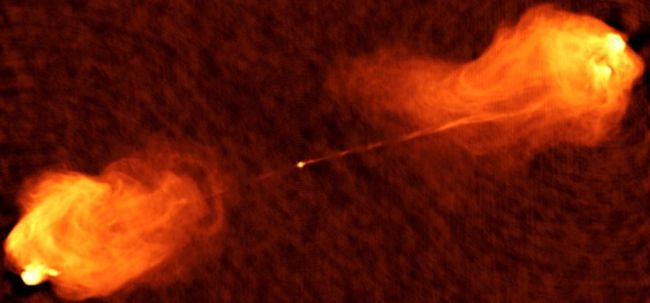Why are some supermassive black hole jets so short? Astronomers may have cracked the case
"These objects are a distinct species all of their own that live and die out in thousands of years rather than the millions of years that are common in galaxies with bigger jets."

A new investigation into a rare and short-lived type of galaxy has revealed that such objects harbor slumbering supermassive black holes that briefly awaken to rip apart a massive star and devour its remains as a giant cosmic breakfast.
"Compact Symmetric Objects," or CSOs, are active galaxies that have two jets blasting out from them at nearly the speed of light. These jets are common to active galactic nuclei (AGN), which have supermassive black holes feeding on surrounding gas and dust at their hearts — but the jets of CSOs are different.
While jets from AGNs can extend for 230,000 light-years in both directions, CSO jets are stunted, stretching for just 1,500 light-years or so.
Scientists had previously theorized that CSO jets are short because they are newly formed or young. Now, a team led by California Institute of Technology (Caltech) scientists has determined that these jets simply have short lifetimes.
"These CSOs are not young. You wouldn't call a 12-year-old dog young even though it has lived a shorter life than an adult human," study team leader Anthony Readhead, an emeritus professor of astronomy at Caltech, said in a statement. "These objects are a distinct species all of their own that live and die out in thousands of years, rather than the millions of years that are common in galaxies with bigger jets."
Get the Space.com Newsletter
Breaking space news, the latest updates on rocket launches, skywatching events and more!
Snacking black holes give galaxies a dog's life
To solve the mystery of CSOs and uncover their true nature, Readhead and colleagues spent two years scouring through 3,000 CSO candidates in past literature and astronomical data from the Very Long Baseline Array (VLBA) and other high-resolution radio telescopes.
"The VLBA observations are the most detailed in astronomy, providing images with details equivalent to measuring the width of a human hair at a distance of 100 miles [160 kilometers]," Readhead said.
The team confirmed 64 of these candidates as CSOs and also spotted an additional 15 of these rare galaxies. Analyzing these CSOs, the team concluded that these rare galaxy types expel jets for just 5,000 years or less and then fade away.
"The CSO jets are very energetic jets, but they seem to shut off," said team member Vikram Ravi, an assistant professor at Caltech. "The jets stop flowing from the source."
The team has identified a suspect in the emission of these jets: They theorize that at the heart of CSOs are supermassive black holes ripping apart stars that get too close to them in so-called "tidal disruption events," or TDEs.

When stars venture too close to a black hole, the latter's immense gravity generates powerful tidal forces within the stellar body. These tidal forces stretch the star vertically while squashing it horizontally, a process called "spaghettification."
This stellar noodle wraps around, forming a disk of matter that is gradually eaten by the supermassive black hole. But black holes are messy eaters, and some of this stellar matter is channeled to the poles of these cosmic monsters. From there, some of the material is blasted away as jets. This TDE process is accompanied by incredibly bright emissions of light that announce these feeding supermassive black holes to astronomers.

"We think that a single star gets ripped apart, and then all that energy is channeled into jets along the axis the black hole is spinning around," Readhead explained. "The giant black hole starts out invisible to us, and then when it consumes a star, boom! The black hole has fuel, and we can see it."
However, it is not just any star that can be the messy cosmic meal that wakes up a black hole as a CSO. The team thinks it is only when a truly massive star gets ripped up by a supermassive black hole in a TDE that a CSO is created.
"The TDEs we've previously seen only lasted for a few years," Ravi explained. "We think that the remarkable TDEs powering CSOs last far longer because the disrupted stars are very large in size, very massive, or both."

Readhead and colleagues were also able to construct a "cosmic family album" showing how CSOs and their jets evolve over time. Younger CSOs have shorter jets that are closer to the central supermassive black hole, while older CSOs have longer jets that stretch farther away from the site of the TDE.
The team determined that while the vast majority of CSOs will die out, 1% of them will go on to have long-lived events with extended jets like those seen in Cygnus A, a distant supermassive black hole whose jets are aimed at Earth, a class of object called a blazar.
In those 1-in-100 long-lived events, the researchers suggest that the central black hole is being fed by extra gas and dust being provided by the merger of its host galaxy with another.
For Readhead, these findings vindicate a theory he first posited in the 1990s, when only three CSOs had been discovered. This idea went mostly unrecognized by the wider scientific community when first suggested but should gain traction with this new evidence.
"The hypothesis was all but forgotten because years went by before observational evidence began to mount for TDEs," Readhead said. "These objects are indeed a distinct population with their own distinct origin, and it is up to us now to learn more about them and how they came to be.
"Being able to study these objects on timescales of years to decades rather than millions of years has opened the door to a whole new laboratory for studying supermassive black holes and the many unexpected and unpredictable surprises they hold."
The team's research was published last month across three studies in the The Astrophysical Journal.
Join our Space Forums to keep talking space on the latest missions, night sky and more! And if you have a news tip, correction or comment, let us know at: community@space.com.

Robert Lea is a science journalist in the U.K. whose articles have been published in Physics World, New Scientist, Astronomy Magazine, All About Space, Newsweek and ZME Science. He also writes about science communication for Elsevier and the European Journal of Physics. Rob holds a bachelor of science degree in physics and astronomy from the U.K.’s Open University. Follow him on Twitter @sciencef1rst.
NASA spacecraft spots monster black hole bursting with X-rays 'releasing a hundred times more energy than we have seen elsewhere'
Could we use black holes to power future human civilizations? 'There is no limitation to extracting the enormous energy from a rotating black hole'









